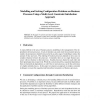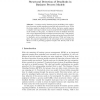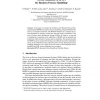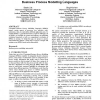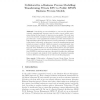131
click to vote
BPSC
2009
15 years 1 months ago
2009
Abstract: In this paper we present our ideas to apply constraint satisfaction on business processes. We propose a multi-level constraint satisfaction approach to handle t levels of...
92
Voted
DAGSTUHL
2006
15 years 1 months ago
2006
Abstract. AMFIBIA is a meta-model that formalizes the essential aspects and concepts of business process modelling. Though AMFIBIA is not the first approach to formalizing the aspe...
117
Voted
APCCM
2006
15 years 1 months ago
2006
UML is posited as the "swiss army knife" for systems modelling and design activities. It embodies a number of modelling formalisms that have broad applicability in captu...
88
Voted
BIS
2008
15 years 1 months ago
2008
Abstract. A common task in business process modelling is the verification of process models regarding syntactical and structural errors. While the former might be checked with low ...
BPM
2005
Springer
15 years 2 months ago
2005
Springer
Abstract. This paper aims at carrying out business process modelling and business process improvement using TAD methodology. The methodology consists of six phases; the first three...
110
Voted
BPM
2006
Springer
15 years 4 months ago
2006
Springer
Abstract. In this paper we examine the suitability of the Business Process Modelling Notation (BPMN) for business process modelling, using the Workflow Patterns as an evaluation fr...
90
Voted
ER
2005
Springer
15 years 6 months ago
2005
Springer
Abstract. Current UML Profiles for Business Process Modelling realise a narrow focus of the process, and capture the process flow on a low level of detail. They do not provide a co...
102
Voted
SAC
2006
ACM
15 years 6 months ago
2006
ACM
Conceptual Business Process Modelling Languages (BPMLs) express certain aspects of processes (e.g. activities, roles, interactions, data, etc.) and address different application a...
117
click to vote
BPM
2007
Springer
15 years 6 months ago
2007
Springer
Abstract. Introducing process orientation to overcome the functionaloriented organizational structure was the main concern within enterprises during the last decade to improve proc...
WECWIS
2009
IEEE
15 years 7 months ago
2009
IEEE
Mainstream business process modelling techniques promote a design paradigm wherein the activities that may be performed within a case, together with their usual execution order, f...
